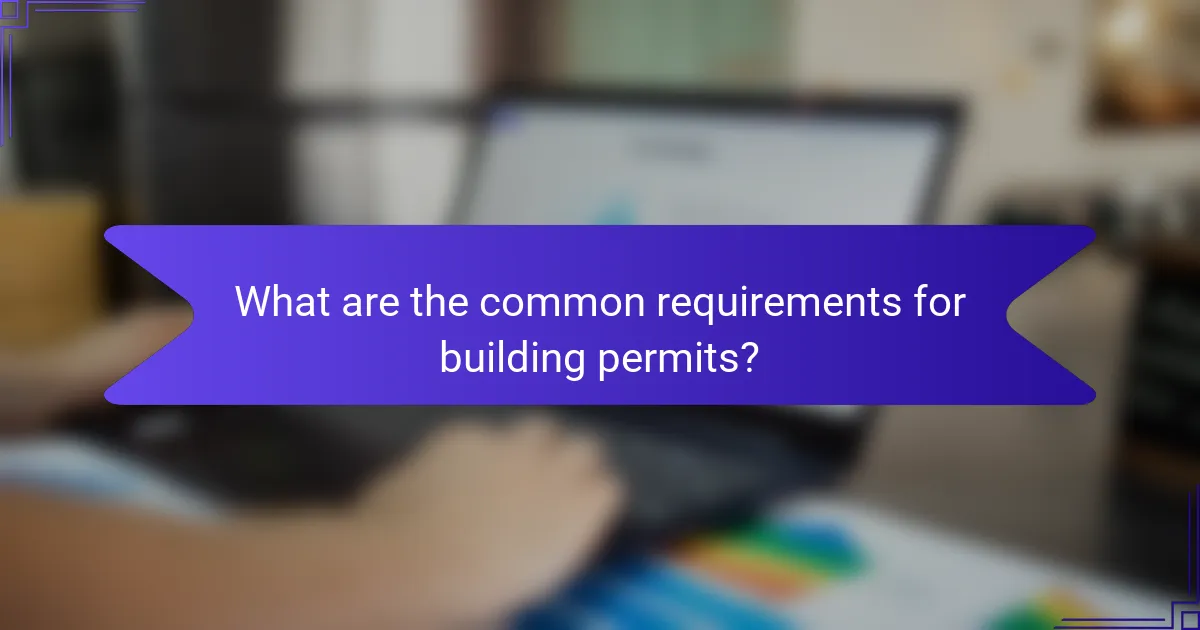Local building codes are essential regulations that dictate construction standards, safety measures, and compliance requirements within specific regions. Understanding these codes is crucial for ensuring that your construction project meets safety and sustainability standards while adhering to national guidelines. Compliance involves obtaining necessary permits, conducting inspections, and working with certified professionals to navigate the complexities of local regulations.

What are the local building codes in South Africa?
Local building codes in South Africa are regulations that govern construction standards, safety, and compliance across various regions. These codes ensure that buildings are safe, sustainable, and meet the needs of the community while adhering to national standards.
National Building Regulations
The National Building Regulations (NBR) provide a framework for building safety and quality across South Africa. They cover aspects such as structural integrity, fire safety, and accessibility, ensuring that all buildings meet minimum safety standards. Compliance with the NBR is mandatory for all construction projects, and local authorities often require proof of adherence before issuing building permits.
Key areas of focus within the NBR include site preparation, foundation design, and materials used in construction. Builders must familiarize themselves with these regulations to avoid costly delays and penalties.
Provincial Amendments
Each province in South Africa may introduce amendments to the National Building Regulations to address local conditions and needs. These amendments can vary significantly, reflecting regional climate, geography, and community requirements. For instance, coastal provinces may have stricter regulations regarding corrosion-resistant materials due to salt exposure.
It is crucial for builders and developers to consult the provincial building authority to understand specific amendments that may impact their projects. Ignoring these can lead to non-compliance and increased costs.
Municipal Regulations
Municipal regulations further refine building codes at the local level, addressing community-specific issues such as zoning, land use, and aesthetic guidelines. These regulations can dictate building heights, setbacks, and even the types of materials that can be used in construction.
Before starting a project, it is essential to check with the local municipality to ensure compliance with these regulations. Engaging with municipal planning departments early in the process can help identify potential challenges and streamline approvals.

How to ensure compliance with building codes?
To ensure compliance with building codes, it is essential to understand the specific regulations applicable to your project and location. This involves obtaining the necessary permits, conducting regular inspections, and engaging certified professionals throughout the construction process.
Obtain necessary permits
Before starting any construction, securing the appropriate permits is crucial. These permits vary by locality and project type, often including zoning, building, and environmental permits. Check with your local building authority to determine which permits are required for your specific project.
Failure to obtain the necessary permits can lead to significant fines, project delays, or even the requirement to dismantle completed work. Always keep a record of your permits and ensure they are displayed on-site as required.
Conduct regular inspections
Regular inspections are vital for maintaining compliance with building codes during construction. These inspections help identify potential issues early and ensure that work is completed according to approved plans and regulations. Schedule inspections at key milestones, such as after foundation work, framing, and before final finishes.
Local building departments typically provide a checklist of items to inspect. Familiarize yourself with these requirements to avoid costly rework and ensure a smooth inspection process.
Engage certified professionals
Hiring certified professionals, such as architects, engineers, and contractors, is essential for navigating building codes effectively. These experts understand local regulations and can help design and execute projects that meet compliance standards. Look for professionals with relevant licenses and experience in your area.
Engaging certified professionals not only enhances the quality of work but also minimizes the risk of non-compliance. Ensure that all hired professionals are up-to-date with the latest building codes and regulations to avoid potential pitfalls during the construction process.

What are the common requirements for building permits?
Common requirements for building permits typically include site plans, structural calculations, and environmental impact assessments. These elements ensure that construction projects comply with local building codes and regulations, promoting safety and sustainability.
Site plans and drawings
Site plans and drawings are essential for illustrating the proposed layout of a construction project. They should include details such as property boundaries, existing structures, and the location of utilities. Accurate site plans help authorities assess compliance with zoning laws and land use regulations.
When preparing site plans, ensure they are drawn to scale and include all relevant dimensions. Commonly, plans must be submitted in formats like PDF or CAD, depending on local requirements. Check with your local building department for specific submission guidelines.
Structural calculations
Structural calculations are critical for demonstrating that a building can safely support the loads it will encounter. These calculations typically cover factors such as weight, wind resistance, and seismic activity, depending on the region. Engineers often perform these assessments to ensure compliance with safety standards.
When submitting structural calculations, include detailed analysis and design specifications. Local codes may require calculations to adhere to specific standards, such as the International Building Code (IBC) or other regional regulations. Consulting with a licensed structural engineer can help ensure accuracy and compliance.
Environmental impact assessments
Environmental impact assessments (EIAs) evaluate the potential effects of a construction project on the surrounding environment. These assessments typically consider factors like air quality, water resources, and wildlife habitats. Many jurisdictions require EIAs to ensure that projects do not harm local ecosystems.
To conduct an EIA, gather data on the project’s location and its potential environmental effects. Engage with local environmental agencies to understand specific requirements and guidelines. Failing to address environmental concerns can lead to project delays or permit denials, so thorough preparation is essential.

How to stay updated on building code changes?
To stay updated on building code changes, regularly check local government resources, engage with industry groups, and participate in relevant educational events. These methods ensure you receive timely information and understand the implications for your projects.
Subscribe to local government newsletters
Local governments often publish newsletters that include updates on building codes, regulations, and compliance requirements. Subscribing to these newsletters is a straightforward way to receive the latest information directly in your inbox.
Check your city or county’s official website for subscription options. Many jurisdictions offer email alerts or downloadable newsletters that cover changes in building codes and related topics.
Join industry associations
Joining industry associations can provide access to valuable resources, including updates on building code changes. These organizations often have dedicated teams that monitor legislative developments and communicate them to members.
Look for associations relevant to your field, such as the National Association of Home Builders or local chapters of construction industry groups. Membership often includes newsletters, webinars, and networking opportunities that keep you informed.
Attend workshops and seminars
Workshops and seminars focused on building codes are excellent opportunities to learn about recent changes and best practices. These events often feature experts who can explain complex regulations and their practical implications.
Check local trade schools, community colleges, or industry associations for upcoming events. Participating in these sessions not only enhances your knowledge but also allows for networking with other professionals who share similar interests.

What are the penalties for non-compliance?
Penalties for non-compliance with local building codes can vary significantly based on jurisdiction and the severity of the violation. Common consequences include fines, mandatory corrections, and potential legal actions against the responsible parties.
Fines and penalties
Fines for non-compliance can range from a few hundred to several thousand dollars, depending on the nature of the violation. For instance, minor infractions may incur lower fines, while serious breaches, such as unsafe structures, could lead to substantial penalties. It’s crucial to check local regulations for specific amounts and conditions.
In some areas, repeated violations may result in increased fines or additional penalties. Staying informed about local building codes can help avoid these financial repercussions.
Mandatory rectification
Mandatory rectification requires property owners to correct any violations identified by local authorities. This may involve making structural changes, obtaining necessary permits, or even demolishing non-compliant constructions. Failure to comply with rectification orders can lead to further penalties.
Rectification timelines can vary, but local authorities typically provide a set period for compliance. It’s advisable to act promptly to avoid additional fines or legal complications.
Legal action and liability
Legal action may be taken against individuals or companies that fail to adhere to building codes, especially if violations pose safety risks. This can include lawsuits from affected parties or actions initiated by local governments. Liability can extend to contractors, architects, and property owners.
Understanding your legal responsibilities under local building codes is essential. Consulting with legal professionals or compliance experts can help mitigate risks associated with potential legal actions.

What are the emerging trends in building codes?
Emerging trends in building codes focus on enhancing sustainability, improving safety, and integrating advanced technologies. These trends reflect a growing awareness of environmental impacts and the need for resilient infrastructure in the face of climate change.
Sustainability and green building standards
Sustainability in building codes emphasizes energy efficiency, resource conservation, and reduced environmental impact. Many jurisdictions are adopting green building standards, such as LEED or BREEAM, which guide developers in creating eco-friendly structures.
When considering sustainability, builders should focus on materials that are renewable or recycled, as well as energy-efficient systems like solar panels and high-efficiency HVAC units. Local regulations may require certain energy performance benchmarks, which can vary widely based on region.
To ensure compliance with sustainability standards, it’s essential to conduct regular audits and stay updated on local building codes. Builders should also engage with local authorities to understand any incentives or rebates available for implementing green technologies, which can help offset initial costs.
